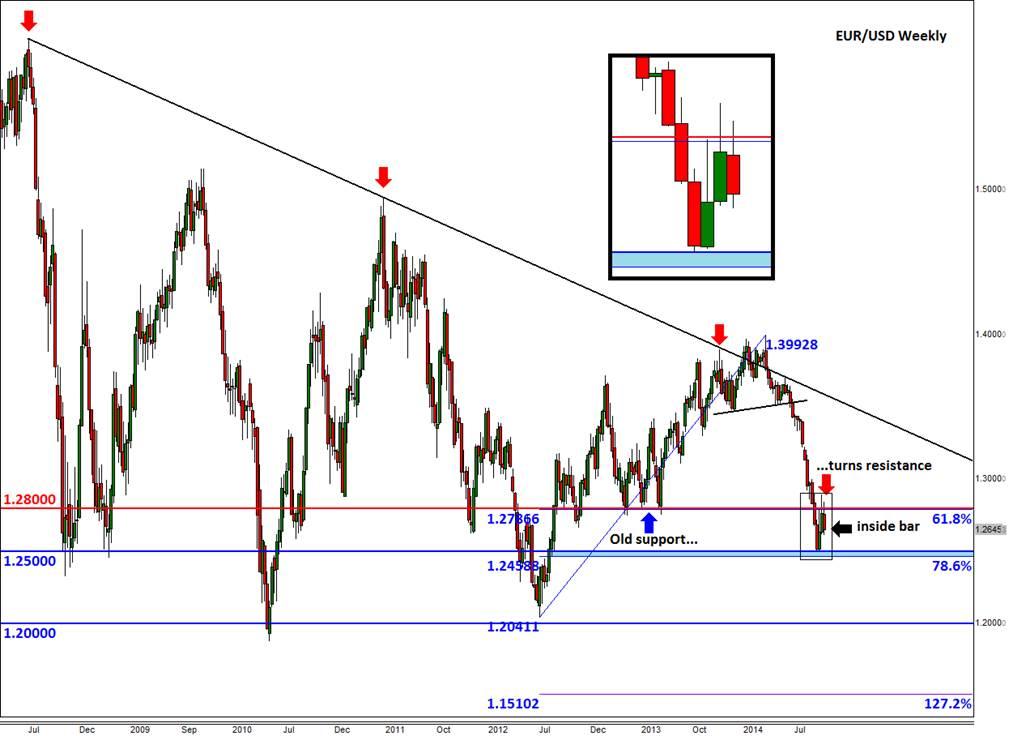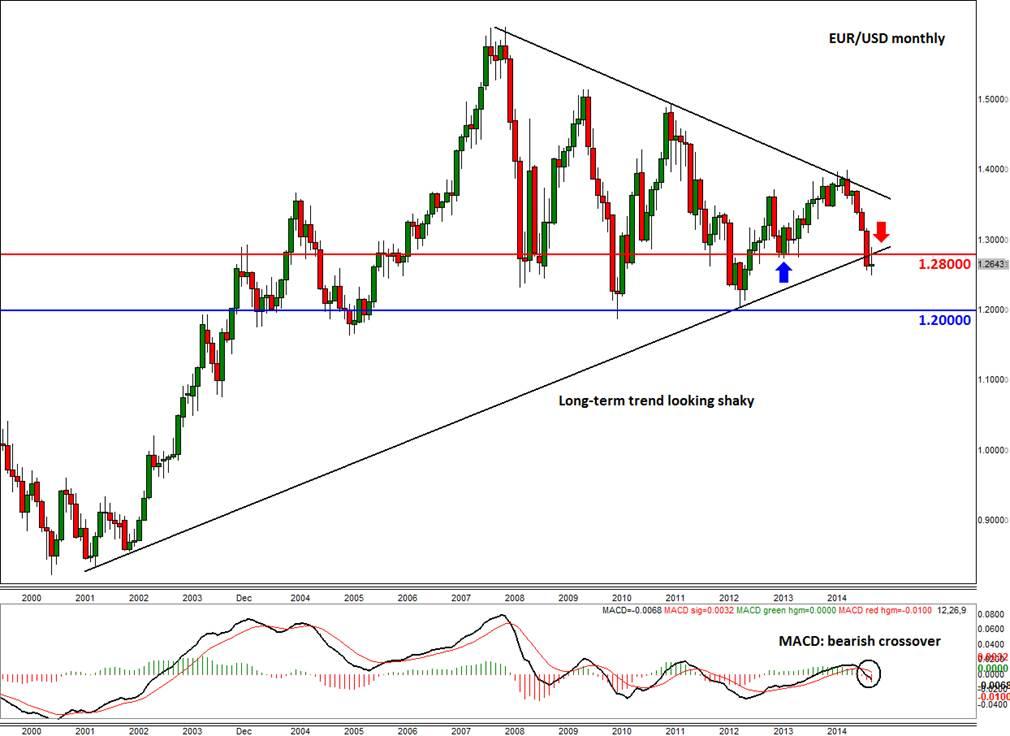![]()
It would have been unimaginable just a few months ago to be talking about the possibility of the euro falling to 1.20 against the dollar. After all, the last time it was low that low was when we were at the height of the Eurozone debt crisis. But this is exactly what could happen over the coming weeks and months. Granted, the situation is a lot better now across the single currency bloc, but that’s not to say a revisit of 1.20 is out of the question, for the monetary policy stances of the ECB (very dovish) and the Fed (becoming less dovish) are in favour of further EUR/USD weakness.
But whether or not the currency pair will make a move towards that level, or indeed stages a more profound recovery, could well be determined by next week’s fundamental events. The outcome of the European banks’ stress test results on Sunday is a major risk for the euro. The last two stress tests failed to reveal problems at lenders that eventually failed. This time, the authorities are expected to take a more comprehensive assessment of the situation and so may reveal some surprising results. On top of the stress tests, there will be plenty of other macro events next week that could have huge impact on the euro – and the dollar for that matter. Among other things, they include the German Ifo business climate on Monday; the CB consumer confidence survey on Tuesday, the FOMC statement on Wednesday, which is widely expected to reveal the Fed has concluded its QE stimulus programme; the German CPI and US GDP both on Thursday, and finally the Eurozone CPI on Friday.
In an unlikely event of a sharp rally this afternoon, the EUR/USD is set to close lower for the first time in three weeks. From a technical point of view, this could be the start of another leg lower for the pair. As the weekly chart shows in figure 1, the euro has consistently failed to hold above the 1.2800 area, which was formerly a major support level. This has now turned into resistance. If the EUR/USD closes the week around the current levels then we would have a candlestick pattern that would look almost like an inside bar formation on the weekly chart. This candlestick pattern, formed within the trading range of the preceding candle, reflects the narrowing of volatility. This is usually the case ahead of key economic events. The narrowing of volatility usually ends abruptly. If next week’s fundamental events are deemed euro-negative – which I think will be the case – the breakout could well be to the downside. A potential break below the key 1.2460/2500 support area (this being a psychological support level and also the 78.6% Fibonacci level – shaded in blue on the chart) would be a particularly bearish outcome. In that case, a potential move towards the 1.20 handle could accelerate.
Meanwhile as the monthly chart shows, in figure 2, a long-term bullish trend line that had been in place since the euro was formed, has broken down. What’s more, the MACD has created a bearish crossover, which, judging by the previous cases usually precedes periods of significant selling pressure.
Trading leveraged products such as FX, CFDs and Spread Bets carry a high level of risk which means you could lose your capital and is therefore not suitable for all investors. All of this website’s contents and information provided by Fawad Razaqzada elsewhere, such as on telegram and other social channels, including news, opinions, market analyses, trade ideas, trade signals or other information are solely provided as general market commentary and do not constitute a recommendation or investment advice. Please ensure you fully understand the risks involved by reading our disclaimer, terms and policies.
Recommended Content
Editors’ Picks
EUR/USD edges lower toward 1.0700 post-US PCE

EUR/USD stays under modest bearish pressure but manages to hold above 1.0700 in the American session on Friday. The US Dollar (USD) gathers strength against its rivals after the stronger-than-forecast PCE inflation data, not allowing the pair to gain traction.
GBP/USD retreats to 1.2500 on renewed USD strength

GBP/USD lost its traction and turned negative on the day near 1.2500. Following the stronger-than-expected PCE inflation readings from the US, the USD stays resilient and makes it difficult for the pair to gather recovery momentum.
Gold struggles to hold above $2,350 following US inflation

Gold turned south and declined toward $2,340, erasing a large portion of its daily gains, as the USD benefited from PCE inflation data. The benchmark 10-year US yield, however, stays in negative territory and helps XAU/USD limit its losses.
Bitcoin Weekly Forecast: BTC’s next breakout could propel it to $80,000 Premium

Bitcoin’s recent price consolidation could be nearing its end as technical indicators and on-chain metrics suggest a potential upward breakout. However, this move would not be straightforward and could punish impatient investors.
Week ahead – Hawkish risk as Fed and NFP on tap, Eurozone data eyed too

Fed meets on Wednesday as US inflation stays elevated. Will Friday’s jobs report bring relief or more angst for the markets? Eurozone flash GDP and CPI numbers in focus for the Euro.

